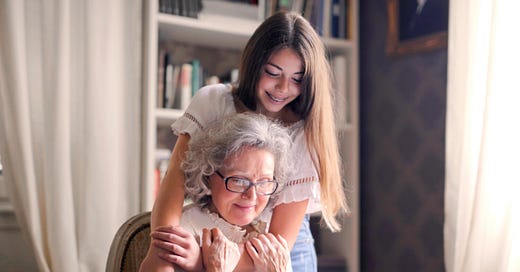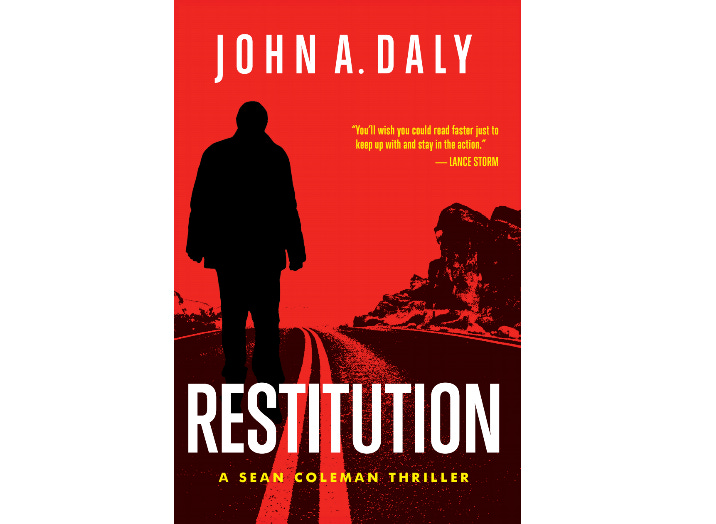Connecting With Your Teenage Grandchildren
A new book offers grandparents guidance for bridging the generational divide.
I mentioned in a previous newsletter than I’ve been doing a series of video interviews for my publisher, in which I’ve been talking to fellow authors about their books. The conversations have been a lot of fun, and it’s been great to meet some talented writers face to face who I’d previously only chatted with through brief email exchanges.
Though I think all of the interviews have been interesting, one in particular covered a topic that really hits home for me. It was with Jerry Witkovsky and Deanna Shoss, co-authors of the upcoming book, “Where Two Worlds Meet: A Guide to Connecting with Your Teenage Grandchildren”.
Jerry, who just turned 94, has been a professional leader for almost 50 years (18 of them as General Director of Chicago’s Jewish Community Centers), and has mentored thousands of individuals. Much of his emphasis over the past 25 years has been on grandparenting and working with multi-generational families.
Deanna is the CEO of Intercultural Talk, Inc., an organization that helps technology-challenged individuals promote their businesses and projects with digital, intercultural, and real-life marketing.
Here’s the premise of their book:
When grandchildren are young, a sweet treat or new toy is enough to inspire their unconditional adoration. And then your grandchildren grow up. Suddenly they are teenagers and it’s not so easy.
With our differences in musical tastes, technology, formative events . . . one could say we are from different worlds.
Where Two Worlds Meet starts with the teenage years, recognizing that your grandchildren are becoming independent beings. It’s an action-focused guide to stay connected and even deepen your relationship with your grandchildren as you both age.
Parents will love this book too, as it helps grandparents respect boundaries as the grandparent, not the parent, and teaches how to develop healthy interdependence. All these ideas work whether you are in the same city or connecting from afar.
Each chapter includes hands-on tactics to put learning into action. It’s peppered with letters from grandchildren of diverse ages and backgrounds, sharing personal stories about a grandparent’s impact on their lives.
Grandparents can have a transformative effect on their family when they unleash their creativity, share their skills, and give voice to the things they are passionate about. Creativity is about bringing your whole self, including your vulnerability, to the relationship with your grandchildren as you enter each other’s world.
The reason this topic resonates with me is that my wife and I have two teenage children, and both sets of our parents are in their 80s. Our parents don’t have a particularly close connection with their grandkids these days, despite living pretty close to each other. To me, that’s unfortunate, and it’s more of an issue with my parents since they have far less grandparenting experience than my wife’s.
As described in the book synopsis, things are pretty easy for grandparents when their grandchildren are little: some spoiling and just being kind of fun and silly around them is enough to win their affection. But teenagers are far more complicated. They’re searching for their path in life, and grandparents are often left feeling as though that path is leading far away from them.
In our interview, Jerry explained that adolescents today are asking themselves, “Who am I?” and “Who do I want to be?”. They’re tempted by drugs and liquor, and learning to drive and make decisions about who should and shouldn’t be allowed in their car. They’re dealing with the pressures of competitive sports, going off to college, and figuring out what kind of field they want to go into.
“That process of a kid growing up…” said Jerry. “How does a grandparent fit into that?”
Jerry and Deanna believe their book provides some answers, including how grandparents can creatively communicate and instill values in their grandchildren, without — and this is important — casting judgement on them.
“It’s normative for teens to be very focused on their own world,” explained Deanna, “and so the fact that we’re now giving grandparents ways to understand that world, so they can enter it and meet them where they are — it’s so important.”
According to Jerry, the research has shown that when grandparents play that role, it enhances the mental health not only of the teenager, but also the mom and dad (many of whom also struggle to understand their teenage kids’ world).
This was of course good news to me, and it should also be good news to a lot of grandparents who want to be in their grandkids’ lives, but are no longer sure how to do it.
If this topic at all applies to you, I’d highly recommend watching the interview in its entirety, as it really was — in my view — quite enlightening (despite me stumbling over my own tongue a few times). Some great tips from the book are also offered.
Oh, and you might get a kick out of the ending.
Where Two Worlds Meet: A Guide to Connecting with Your Teenage Grandchildren releases in June, but it’s already available for pre-order.
I’ve already reserved a copy myself.
Do you have teenage grandkids? Do you have your own tips and tricks that have brought you closer to them? Let me know what has worked in an email or in the comment section below.
Random Thought


Obligatory Dog Shot
Shhh.
Have you picked up your copy of RESTITUTION?
My new book “Restitution: A Sean Coleman Thriller” is out now! You can get it on Amazon, Apple, Barnes & Noble, Kobo, Books-A-Million, and wherever else books are sold.
Interested in a signed copy of Restitution or any of my other books? You can order them here. And remember, a signed, personalized copy also makes a great gift!
Already read and enjoyed Restitution? I’d love if you could leave a review for the book on Amazon (it triggers Amazon to suggest my work to other readers).
Featured Vinyl
Believe it or not, this week’s selection does technically qualify as vinyl; just very thin vinyl. It’s a flexi-disc, and if you’re around my age, you may have occasionally discovered one in a box of cereal when you were a kid. Only, this one doesn’t smell like grain, and the artwork isn’t nearly as wholesome.
It’s a newly released, very limited edition, remix of the 1989 Toadies single, “Got a Heart.” It’s being sold on the band’s website in a t-shirt bundle, with a portion of the proceeds going to Lisa Umbarger, the band’s original bassist, who is going through cancer treatment.
The song offers a taste of the band’s early, punk-influenced sound. It was originally recorded a few years before they exploded onto the rock scene with their first full-length album, 1994’s Rubberneck.
As I’ve mentioned in past newsletters, I like pretty much everything by the Toadies, and this song’s no exception.
That’s all for now. Thanks for reading today’s Daly Grind.
Want to drop me a line? You can email me at johndalybooks@hotmail.com, and also follow me on Facebook, Twitter, and Instagram. If you haven’t subscribed to this newsletter yet, please click on the “Subscribe now” button below. Doing so will get these posts emailed directly to you.
Also, if you’re not caught up on my Sean Coleman Thrillers, you can pick the entire series up at a great price on Amazon. And if you’re interested in signed, personalized copies of my books, you can order them directly from my website.
Take care. And I’ll talk to you soon!









